How High is the Everest Base Camp? 10 Things You Must Know about Everest.
Everest Base Camp (EBC) is one of the most iconic trekking destinations in the world, and for good reason.
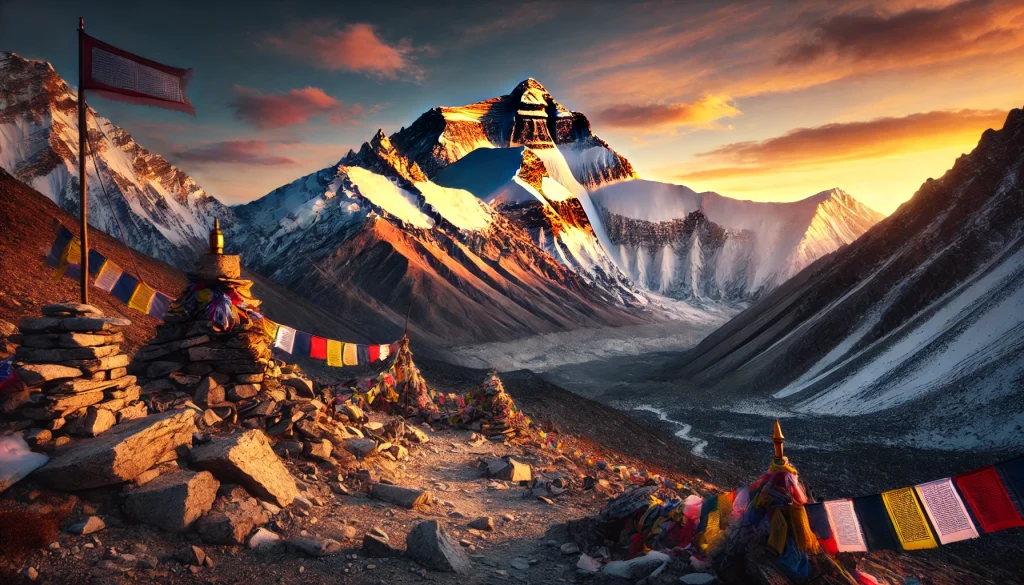
It’s the gateway to Mount Everest, the highest mountain on Earth, and offers trekkers an unparalleled view of the Himalayas.
While EBC is a popular destination for adventurers, many people wonder, “How high is Everest Base Camp?” and what else do I need to know before embarking on this journey?
In this article, we’ll cover the elevation of Everest Base Camp, as well as 10 essential things you must know about trekking to this legendary destination.
- How High is Everest Base Camp?
Everest Base Camp is located at an altitude of 5,364 meters (17,598 feet) on the south side of Mount Everest, in Nepal. The camp serves as the starting point for climbers attempting to summit the world’s tallest peak. Although it’s not as high as the summit, EBC offers spectacular views of Everest, Lhotse, Nuptse, and other towering peaks.
EBC South (Nepal): 5,364 meters (17,598 feet)
EBC North (Tibet): 5,150 meters (16,900 feet)
The trek to EBC takes you through various elevations, with the highest point of the trek being Kala Patthar, a famous viewpoint that sits at 5,545 meters (18,192 feet) and offers stunning views of Everest.
- Altitude Sickness: The Importance of Acclimatization
One of the most critical aspects of the Everest Base Camp trek is acclimatization. At altitudes above 3,000 meters (10,000 feet), your body begins to experience less oxygen, and the risk of altitude sickness increases. Symptoms include headache, dizziness, nausea, and shortness of breath.
To prevent altitude sickness, trekkers should:
Take rest days during the trek (usually at places like Namche Bazaar and Dingboche) to allow the body to adjust.
Ascend gradually to avoid rapid elevation gain.
Stay hydrated and eat high-energy food.
It’s crucial not to rush the trek and listen to your body, as altitude sickness can be life-threatening if not addressed properly.
- The Best Time to Trek to Everest Base Camp
The ideal seasons for trekking to Everest Base Camp are during the pre-monsoon (spring) and post-monsoon (autumn) seasons:
Spring (March-May): This is the most popular time to trek to EBC. The weather is clear, temperatures are relatively mild, and the views are spectacular. It also coincides with the spring climbing season for those attempting to summit Everest.
Autumn (September – November): This is another excellent time for trekking, as the weather is still clear, and temperatures are cool but manageable. The monsoon rains are over, and the trails are less muddy.
Avoid trekking during the monsoon (June – August) as the trails are slippery, and visibility is poor due to heavy rain and clouds. Winter (December – February) is also challenging due to cold temperatures and the potential for snow.
- How Long Does It Take to Trek to Everest Base Camp?
The trek to Everest Base Camp typically takes around 12-14 days, depending on your pace and the number of rest days you take for acclimatization. Here’s a typical itinerary:
The Route: A Scenic and Challenging Trek
The journey to EBC takes trekkers through the Khumbu region, offering spectacular mountain views, Sherpa villages, Buddhist monasteries, and lush forests. Here’s a quick breakdown of the main stops along the way:
- Day 1-2: Fly from Kathmandu to Lukla and trek to Phakding (2,652 meters).
- Day 3-4: Trek to Namche Bazaar (3,440 meters).
- Day 5-6: Acclimatization day at Namche Bazaar (short hikes to Everest View Hotel or Khumjung).
- Day 7-9: Trek to Tengboche (3,860 meters), Dingboche (4,410 meters), and Lobuche (4,940 meters).
- Day 10-11: Reach Everest Base Camp (5,364 meters), and trek to Kala Patthar for sunrise views.
- Day 12-14: Descend back to Lukla and fly back to Kathmandu.
Lukla: Starting point, where you’ll fly in from Kathmandu.
Phakding: The first stop after Lukla, a peaceful village by the Dudh Koshi River.
Namche Bazaar: The main hub of the Khumbu region, famous for its markets and great views of the Himalayas.
Tengboche: Known for its monastery and stunning vistas of Everest and other peaks.
Dingboche: A popular acclimatization stop.
Lobuche: A small settlement where you’ll stay before reaching EBC.
Gorak Shep: The last stop before reaching Everest Base Camp, located just a few hours’ walk from the base camp.
- Trekking with a Guide and Porter
While it’s possible to trek to EBC independently, hiring a guide and/or porter can significantly enhance your experience. A guide can provide local knowledge, ensure safety, help navigate the trails, and offer insight into the Sherpa culture and Buddhist traditions of the region. A porter can carry your heavy backpack, allowing you to focus on enjoying the trek.
If you prefer a self-guided trek, you should have previous trekking experience and feel comfortable navigating mountain trails on your own.
- Essential Gear for the Everest Base Camp Trek
Given the high altitude, unpredictable weather, and rugged terrain, it’s important to pack the right gear for the EBC trek. Here’s a checklist of essential equipment:
Trekking boots: Waterproof, durable, and comfortable for long hikes.
Sleeping bag: A four-season sleeping bag rated to -10°C (14°F).
Clothing layers: Include moisture-wicking base layers, fleece jackets, and a down jacket for warmth.
Daypack: To carry essentials such as water, snacks, and a camera.
Trekking poles: These help with balance and reduce strain on the knees.
Sun protection: Sunglasses, sunscreen, and a hat are essential due to the strong UV rays at high altitudes.
Water bottle and purification system: Carry a refillable water bottle and a filtration system or purification tablets.
- Accommodation Along the Trail
Along the EBC trek, you’ll stay in tea houses, small guesthouses run by local families. These simple accommodations offer basic amenities, including a bed, heating (in some places), and food. Most tea houses also provide charging facilities for electronic devices, though there may be an additional fee.
Accommodation becomes more basic as you ascend, especially above Dingboche and Gorak Shep, where the weather is colder and facilities are more limited.
Food and Water on the Trek
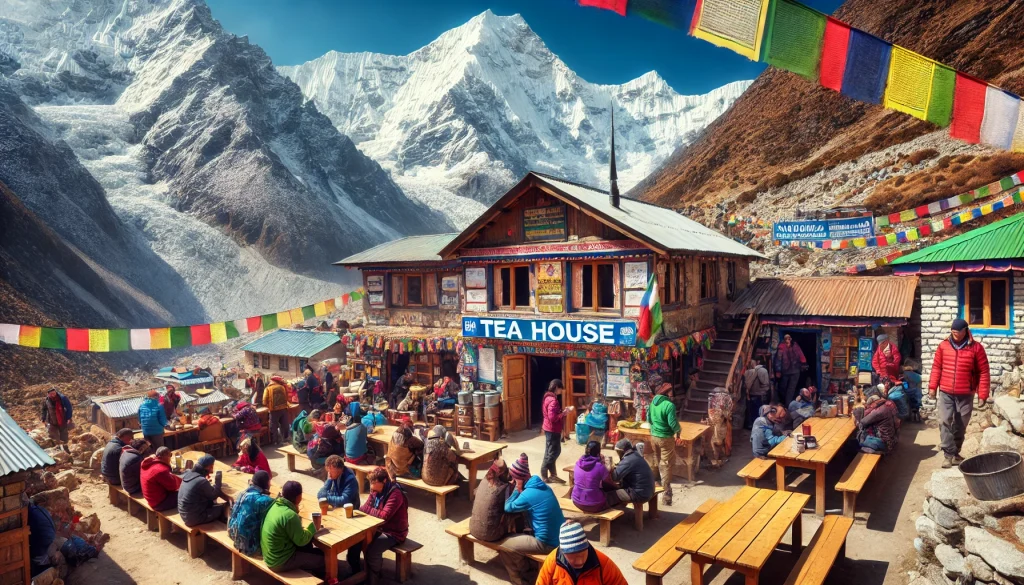
Tea houses along the Everest Base Camp trek offer a variety of meals, including:
Dal Bhat: The traditional Nepali dish of lentils and rice, a high-energy meal.

Momos: Nepali dumplings, often filled with vegetables or meat.

Tibetan bread: A delicious bread served with jam or butter.
Pasta, pizza, and soups: Available in some tea houses, especially in the lower sections of the trail.
Due to the altitude, it’s important to drink plenty of water. Boiled water is usually available at tea houses, or you can bring a water purifier or tablets. Avoid drinking untreated water from streams.
- Safety and Insurance
Trekking to Everest Base Camp can be challenging, especially with the high altitudes. Before you go, ensure you have travel insurance that covers high-altitude trekking, emergency evacuation, and medical expenses.
Altitude sickness can affect anyone, regardless of experience, so make sure you’re prepared to turn back if necessary.
Emergency evacuation is sometimes needed for serious medical conditions, which can be costly without the right insurance.
Helicopter rescue can be arranged if you cannot descend under your power, though it’s important to remember that the terrain can be difficult to navigate.
The trek to Everest Base Camp is an unforgettable journey through one of the world’s most beautiful and dramatic mountain landscapes.
While the altitude, terrain, and weather can be challenging, the experience of standing at the foot of Mount Everest and gazing at the towering peaks around you is well worth the effort. Whether you’re a seasoned trekker or a first-time adventurer, the trek to EBC offers incredible rewards and lasting memories.
Remember, proper preparation, pacing yourself, and staying safe are the keys to making your Everest Base Camp trek an experience of a lifetime!
10 Things You Must Know About Everest Base Camp
Table of Contents
- Introduction to Everest Base Camp
- Altitude of Everest Base Camp
- Trekking Routes to Everest Base Camp
- Best Time to Visit Everest Base Camp
- Physical Fitness and Training Requirements
- Permits and Documentation
- Accommodation and Food on the Trek
- Packing Essentials for the Trek
- Culture and Local Communities
- Responsible Trekking Practices
1. Introduction to Everest Base Camp
Everest Base Camp (EBC), at the base of the world’s highest mountain, Mount Everest, serves as a gateway for mountaineers and a dream destination for trekkers.
Located in Nepal’s Solu-Khumbu region, EBC offers breathtaking views, diverse landscapes, and insights into the Himalayan way of life. For most travelers, reaching this iconic spot represents a personal achievement and a spiritual connection with nature.
Backlink Tip: Link to the official Nepal Tourism website for credibility.
2. Altitude of Everest Base Camp
The altitude of Everest Base Camp is 5,364 meters (17,598 feet) above sea level. This high-altitude environment is physically challenging due to the lower oxygen levels, often causing altitude sickness. Acclimatization is critical, and trekkers typically spend several days ascending slowly to avoid complications.
To compare, the air pressure at this altitude is roughly 50% of what it is at sea level, making even small physical efforts feel taxing. For mountaineers, Everest Base Camp begins their journey to scale Everest’s 8,848-meter (29,029 feet) peak.
3. Trekking Routes to Everest Base Camp
There are two primary trekking routes to Everest Base Camp:
- Classic Route from Lukla: The most popular option, starting with a flight from Kathmandu to Lukla. This trek takes about 12–14 days.
- Jiri to EBC Route: A longer trek (20–24 days) following the footsteps of early Everest expeditions, offering scenic rural landscapes.
Both routes pass through iconic stops like Namche Bazaar, Tengboche Monastery, and Kala Patthar, a vantage point offering stunning views of Everest.
4. Best Time to Visit Everest Base Camp
The ideal time to visit EBC depends on the season:
- Spring (March-May): Clear skies, blooming rhododendrons, and moderate temperatures.
- Autumn (September–November): The most popular season due to stable weather, excellent visibility, and comfortable trekking conditions.
- Winter (December–February): Cold but less crowded, offering solitude for experienced trekkers.
- Monsoon (June–August): Heavy rain, slippery trails, and fewer trekkers.
Backlink Tip: Link to a weather-focused resource for weather updates in Nepal.
5. Physical Fitness and Training Requirements
Preparing for the Everest Base Camp trek involves a mix of cardiovascular, strength, and endurance training. Here’s what to focus on:
- Cardio: Regular running, cycling, or swimming to build lung capacity.
- Strength: Leg workouts like squats and lunges to prepare for uphill climbs.
- Hiking Practice: Practice with a weighted backpack on varied terrains.
While no technical climbing is required, the trek is physically demanding. It’s crucial to prepare months in advance to handle long days of walking at high altitudes.
6. Permits and Documentation
Trekking to EBC requires:
- Sagarmatha National Park Entry Permit (around USD 30)
- Khumbu Pasang Lhamu Rural Municipality Permit (around $20)
Both can be obtained in Kathmandu or Monjo if trekking via Jiri, an additional Gaurishankar Conservation Area Permit may be necessary. Always carry your passport and permit copies while trekking.
7. Accommodation and Food on the Trek
- Accommodation: Lodges (commonly called tea houses) are available at most stops. Rooms are basic but comfortable, often equipped with twin beds.
- Food: Meals include dal bhat (rice and lentils), noodles, soups, and momos (dumplings). While food gets pricier as you ascend, it remains hearty and nutritious.
Pro Tip: Carry snacks like energy bars or dried fruits for the trail.
8. Packing Essentials for the Trek
Here’s a checklist of must-pack items:
- Clothing: Thermal layers, waterproof jacket, trekking pants, gloves, and a hat.
- Footwear: Sturdy trekking boots and extra socks.
- Gear: Trekking poles, sleeping bag, and a daypack.
- Health: Altitude sickness medication, sunscreen, and a first aid kit.
Tip: Pack light but ensure essentials are covered, as porters can only carry a limited load.
9. Culture and Local Communities
The trek to EBC is as much a cultural journey as a physical one. The Sherpa community, known for their hospitality and mountaineering skills, plays a pivotal role in the Everest region. Visiting ancient monasteries like Tengboche Monastery provides insight into Buddhist traditions.
Respect local customs by dressing modestly, seeking permission before taking photos, and learning a few basic Nepali or Sherpa phrases.
10. Responsible Trekking Practices
Preserving the pristine environment of the Everest region is essential. Follow these practices:
- Leave No Trace: Carry all waste back to disposal points.
- Respect Wildlife: Avoid disturbing animals or picking plants.
- Use Eco-Friendly Products: Avoid single-use plastics whenever possible.
Supporting local businesses and guides also ensures sustainable tourism in the region.
Conclusion
The journey to Everest Base Camp is a life-changing experience, blending natural beauty, cultural immersion, and personal growth. By being well-prepared and mindful of the environment, you can make the most of your trek and leave with cherished memories.
Image Suggestions
- A stunning sunrise view of Everest from Kala Patthar.
- A bustling tea house in Namche Bazaar.
- A group of trekkers crossing a suspension bridge with prayer flags.
How High is Everest Base Camp?
Everest Base Camp (EBC) is located at an elevation of 5,364 meters (17,598 feet) on the Nepal side (South Base Camp) and 5,150 meters (16,900 feet) on the Tibet side (North Base Camp).
10 Things You Must Know About Everest Base Camp
- Two Base Camps: Everest has two base camps—the South Base Camp in Nepal and the North Base Camp in Tibet. The South Base Camp is more popular for trekkers, while the North Base Camp is accessible by road.
- Trekking Duration: The classic trek to South Base Camp takes 12-14 days, covering approximately 130 kilometers round trip.
- Altitude Challenges: The high altitude poses risks like altitude sickness. Proper acclimatization is crucial, with rest days recommended at Namche Bazaar (3,440m) and Dingboche (4,410m) .
- Best Time to Visit: The ideal seasons are March-May (spring) and September-November (autumn), when the weather is stable and visibility is clear.
- Starting Point: The trek begins with a flight from Kathmandu to Lukla (2,860m), one of the world’s most dangerous airports.
- Facilities: South Base Camp has rudimentary facilities like a field hospital and heliport, while North Base Camp offers tourist accommodations like tea houses and tent villages.
- Cultural Experience: The trek passes through Sherpa villages like Namche Bazaar, offering insights into Sherpa culture and hospitality.
- Environmental Concerns: The South Base Camp is being relocated 200-400 meters lower due to the rapid melting of the Khumbu Glacier.
- Helicopter Tours: For those short on time, helicopter tours to EBC are available, offering breathtaking aerial views of Everest.
- Historical Significance: EBC is the starting point for climbers attempting to summit Everest, following the footsteps of Sir Edmund Hillary and Tenzing Norgay.
30 FAQs About Everest Base Camp
General Information
- What is the elevation of Everest Base Camp?
- South Base Camp: 5,364m (17,598ft); North Base Camp: 5,150m (16,900ft).
- Where is Everest Base Camp located?
- South Base Camp is in Nepal, and North Base Camp is in Tibet.
- How long does it take to trek to Everest Base Camp?
- Typically 12-14 days for the round trip.
- What is the best time to visit Everest Base Camp?
- March-May and September-November.
- Can you see Mount Everest from Base Camp?
- No, but nearby Kala Patthar (5,545m) offers a clear view.
Trekking Details
- What is the starting point of the EBC trek?
- Lukla is accessible by flight from Kathmandu.
- How difficult is the Everest Base Camp trek?
- Moderately difficult, requiring good fitness and acclimatization.
- What is the total distance of the EBC trek?
- Approximately 130 kilometers round trip.
- Are there rest days during the trek?
- Yes, at Namche Bazaar and Dingboche for acclimatization.
- What is the highest point on the EBC trek?
- Kala Patthar at 5,545m (18,192ft) .
Altitude and Health
- What are the risks of high altitude on the EBC trek?
- Altitude sickness, headaches, nausea, and fatigue.
- How can I prevent altitude sickness?
- Ascend gradually, stay hydrated, and take rest days.
- What is the oxygen level at Everest Base Camp?
- About 50% of sea level oxygen.
- Can children or elderly people trek to EBC?
- It’s possible with proper preparation and acclimatization.
- Is there medical help available on the trek?
- Yes, basic medical facilities and helicopter rescue services are available.
Logistics and Preparation
- Do I need a permit to trek to Everest Base Camp?
- Yes, a Sagarmatha National Park permit and TIMS card are required.
- What should I pack for the EBC trek?
- Warm clothing, sturdy boots, a sleeping bag, and altitude sickness medication.
- Are guides and porters necessary?
- Recommended for safety and to ease the physical burden.
- Can I trek to EBC solo?
- Yes, but it’s safer with a guide, especially for first-timers.
- What is the cost of the EBC trek?
- Approximately $1,000-$2,000, depending on the package.
Cultural and Environmental Aspects
- What is the Sherpa culture like?
- Rich in traditions, with warm hospitality and Buddhist influences.
- Are there monasteries along the trek?
- Yes, like Tengboche Monastery, offering cultural insights.
- Why is the South Base Camp being relocated?
- The melting of the Khumbu Glacier makes the current site unsafe.
- What is the environmental impact of trekking to EBC?
- High, with concerns about waste management and glacier melting.
- Are there Wi-Fi and communication facilities at EBC?
- Yes, Wi-Fi is available through Everest Link and China Telecom.
Climbing and Expeditions
- How many camps are there above Everest Base Camp?
- Four camps (Camp 1 to Camp 4) before the summit.
- What is the elevation gain from EBC to the summit?
- Approximately 3,485 meters (11,434 feet).
- What is the “Death Zone” on Everest?
- The area above 8,000m where oxygen levels are critically low.
- How long does it take to climb Everest from Base Camp?
- About 40-60 days, including acclimatization and summit attempts.
- What is the success rate of summiting Everest?
- Around 60-70%, depending on weather and climber experience.
1. Official Tourism Websites
- Nepal Tourism Board: https://www.welcomenepal.com
(For information about permits, trekking routes, and cultural insights.) - Tibet Tourism Bureau: http://en.tibettour.org
(For details about North Base Camp and Tibet travel regulations.)
2. Trekking and Adventure Websites
- Himalayan Rescue Association: https://www.himalayanrescue.org
(For altitude sickness prevention and medical advice.) - The International Mountain Guides (IMG): https://www.mountainguides.com
(For climbing expeditions and trekking tips.)
3. Environmental and Scientific Organizations
- International Centre for Integrated Mountain Development (ICIMOD): https://www.icimod.org
(For information about glacier melting and environmental concerns.) - NASA Earth Observatory: https://earthobservatory.nasa.gov
(For satellite images and studies on Everest’s changing landscape.)
4. News and Media Outlets
- BBC Travel: https://www.bbc.com/travel
(For articles on trekking experiences and cultural insights.) - National Geographic: https://www.nationalgeographic.com
(For high-quality visuals and in-depth stories about Everest.)
5. Travel Blogs and Forums
- The Trek: https://thetrek.co
(For personal trekking stories and practical advice.) - TripAdvisor: https://www.tripadvisor.com
(For reviews and recommendations from fellow travelers.)
6. Government and Permit Information
- Sagarmatha National Park: https://www.sagarmathanationalpark.gov.np
(For permit details and park regulations.) - China Tibet Tourism Bureau: http://en.tibettour.org
(For Tibet travel permits and North Base Camp information.)
7. Weather and Climate Resources
- Mountain Forecast: https://www.mountain-forecast.com
(For Everest weather updates and climbing conditions.) - AccuWeather: https://www.accuweather.com
(For seasonal weather trends in the Everest region.)
8. Historical and Cultural Resources
- Everest History: https://www.everesthistory.com
(For historical accounts of Everest expeditions.) - Sherpa Culture and Traditions: https://www.sherpa-adventure.com
(For insights into Sherpa culture and traditions.)
9. Equipment and Gear Guides
- REI Co-op: https://www.rei.com
(For trekking gear recommendations and packing lists.) - OutdoorGearLab: https://www.outdoorgearlab.com
(For reviews of high-altitude trekking equipment.)
10. Helicopter and Emergency Services
- Fishtail Air: https://www.fishtailair.com
(For helicopter tours and emergency evacuation services.) - Simrik Air: https://www.simrikair.com
(For scenic flights and rescue operations.)
11. Environmental and Conservation Efforts
- Everest Summiteers Association: https://www.everestsummiteersassociation.org
(For initiatives to clean up Everest and promote sustainable tourism.) - World Wildlife Fund (WWF): https://www.worldwildlife.org
(For information about Himalayan ecosystems and conservation efforts.)
12. Maps and Navigation Tools
- Google Maps: https://www.google.com/maps
(For satellite views of the Everest region.) - Caltopo: https://caltopo.com
(For detailed trekking maps and route planning.)
13. Health and Safety Resources
- Centers for Disease Control and Prevention (CDC): https://www.cdc.gov
(For health advisories and vaccination recommendations.) - Travel Health Pro: https://travelhealthpro.org.uk
(For altitude sickness prevention and travel health tips.)
14. Photography and Inspiration
- Instagram: https://www.instagram.com
(Search for hashtags like #EverestBaseCamp or #EBC for inspiration.) - 500px: https://www.500px.com
(For stunning photography of Everest and the Himalayas.)
15. Booking and Tour Operators
- G Adventures: https://www.gadventures.com
(For guided trekking tours to Everest Base Camp.) - Intrepid Travel: https://www.intrepidtravel.com
(For small-group trekking adventures.)
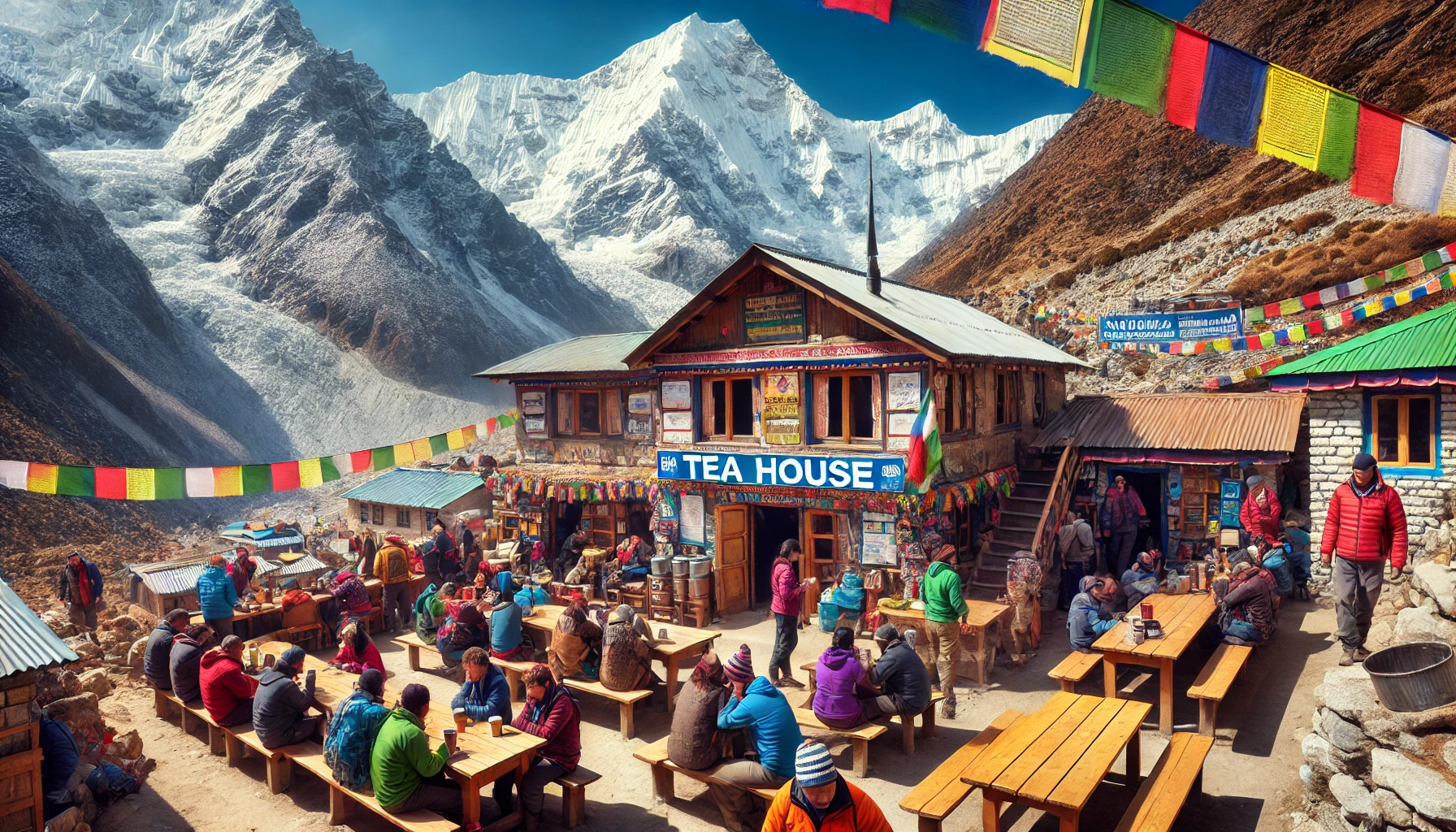
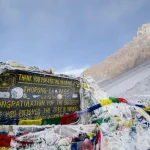


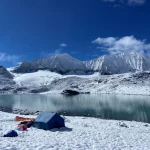
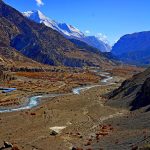
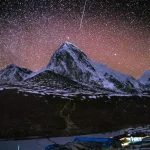


Wow! I’ve always wondered, how high is Everest Base Camp exactly, and what’s it like to be up there?
Everest Base Camp sits at 5,364 meters (17,598 feet) above sea level! It’s an incredible experience—stunning views, crisp mountain air, and a real sense of being at the roof of the world.
Wow, Everest Base Camp sounds incredible! How high is it exactly, and what should I be prepared for when visiting?
Everest Base Camp sits at 5,364 meters (17,598 feet) above sea level! Prepare for chilly weather, stunning mountain views, and an unforgettable trekking experience.